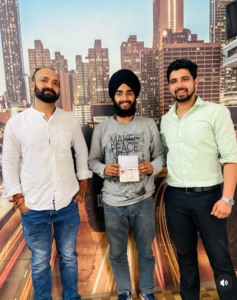READING PASSAGE 3
You should spend about 20 minutes on Questions 28-40, which are based on Reading Passage 3 below.
The real risks of artificial intelligence
If you believe some AI-watchers, we are racing towards the Singularity – a point at which artificial intelligence outstrips our own and machines go on to improve themselves at an exponential rate. If that happens – and it’s a big if – what will become of us?
In the last few years, several high-profile voices, from Stephen Hawking to Elon Musk and Bill Gates have warned that we should be more concerned about possible dangerous outcomes of supersmart AI. And they’ve put their money where their mouth is: Musk is among several billionaire backers of OpenAI, an orgnisation dedicated to developing AI that will benefit humanity.
But for many, such fears are overblown. As Andrew Ng at Stanford University, who is also chief scientist at Chinese internet giant Baidu, puts it: fearing a rise of killer robots is like worrying about overpopulation on Mars.
That’s not to say our increasing reliance on AI does not carry real risks, however. In fact, those risks are already here. As smart systems become involved in ever more decisions in arenas ranging from healthcare to finance to criminal justice, there is a danger that important parts of our lives are being made without sufficient scrutiny. What’s more, AIs could have knock-on effects that we have not prepared for, such as changing our relationship with doctors to the way our neighbourhoods are policed.
What exactly is AI? Very simply, it’s machines doing things that are considered to require intelligence when humans do them: understanding natural language, recognising faces in photos, driving a car, or guessing what other books we might like based on what we have previously enjoyed reading. It’s the difference between a mechanical arm on a factory production line programmed to repeat the same basic task over and over again, and an arm that learns through trial and error how to handle different tasks by itself.
How is AI helping us? The leading approach to AI right now is machine learning, in which programs are trained to pick out and respond to patterns in large amounts of data, such as identifying a face in an image or choosing a winning move in the board game Go. This technique can be applied to all sorts of problems, such as getting computers to spot patterns in medical images, for example. Google’s artificial intelligence company DeepMind are collaborating with the UK’s National Health Service in a handful of projects, including ones in which their software is being taught to diagnose cancer and eye disease from patient scans. Others are using machine learning to catch early signs of conditions such as heart disease and Alzheimers.
Artificial intelligence is also being used to analyse vast amounts of molecular information looking for potential new drug candidates – a process that would take humans too long to be worth doing. Indeed, machine learning could soon be indispensable to healthcare.
Artificial intelligence can also help us manage highly complex systems such as global shipping networks. For example, the system at the heart of the Port Botany container terminal in Sydney manages the movement of thousands of shipping containers in and out of the port, controlling a fleet of automated, driverless straddle-carriers in a completely human-free zone. Similarly, in the mining industry, optimisation engines are increasingly being used to plan and coordinate the movement of a resource, such as iron ore, from initial transport on huge driverless mine trucks, to the freight trains that take the ore to port.
AIs are at work wherever you look, in industries from finance to transportation, monitoring the share market for suspicious trading activity or assisting with ground and air traffic control. They even help to keep spam out of your inbox. And this is just the beginning for artificial intelligence. As the technology advances, so too does the number of applications.
So what’s the problem? Rather than worrying about a future AI takeover, the real risk is that we can put too much trust in the smart systems we are building. Recall that machine learning works by training software to spot patterns in data. Once trained, it is then put to work analysing fresh, unseen data. But when the computer spits out an answer, we are typically unable to see how it got there.
There are obvious problems here. A system is only as good as the data it learns from. Take a system trained to learn which patients with pneumonia had a higher risk of death, so that they might be admitted to hospital. It inadvertently classified patients with asthma as being at lower risk. This was because in normal situations, people with pneumonia and a history of asthma go straight to intensive care and therefore get the kind of treatment that significantly reduces their risk of dying. The machine learning took this to mean that asthma + pneumonia = lower risk of death.
As AIs are rolled out to assess everything from your credit rating to suitability for a job you are applying for to criminals’ chance of reoffending, the risks that they will sometimes get it wrong – without us necessarily knowing – get worse.
Since so much of the data that we feed AIs is imperfect, we should not expect perfect answers all the time. Recognising that is the first step in managing the risk. Decision-making processes built on top of AIs need to be made more open to scrutiny. Since we are building artificial intelligence in our own image, it is likely to be both as brilliant and as flawed as we are.
Questions 28-36
Complete the sentences below.
Write NO MORE THAN TWO WORDS from the passage for each answer.
Write your answers in boxes 28-36 on your answer sheet.
28. Singularity is the point, where AI our own machines.
29. Many people, including Stephen Hawking, Elon Musk and Bill Gates warned us about possible of supersmart AI.
30. According to Andrew Ng, fearing a rise of is similar to worrying about overpopulation on Mars.
31. There is a danger that many important parts of our lives, like healthcar, finance and will be without sufficient scrutiny.
32. Simply put, AI is machines doing things that are considered to require when humans do them.
33. Nowadays, the main approach to AI is .
34. DeepMind in collaboration with the UK’s National Health Service works on many projects, including the one where software learns how to and eye disease.
35. In the nearest future machine learning could be to healthcare.
36. AI might also help in managing networks.
Questions 37-40
Do the following statements agree with the information given in Reading Passage 3?
In boxes 37–40 on your answer sheet, write
TRUE if the statement agrees with the information
FALSE if the statement contradicts the information
NOT GIVEN if there is no information on this
37. AI works in many different industries nowadays. Choose TRUE FALSE NOT GIVEN
38. We shouldn’t put too much trust in AI in the future. Choose TRUE FALSE NOT GIVEN
39. The quality of the data doesn’t affect the ability of AI to learn information correctly. Choose TRUE FALSE NOT GIVEN
40. We can get perfect answers from AI all the time. Choose TRUE FALSE NOT GIVEN








